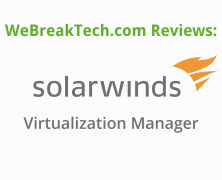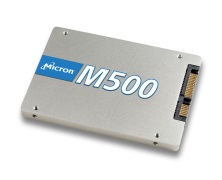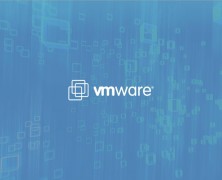Solarwinds Virtualization Manager ensures your IT department is agile enough to solve problems before they arise, provides the insights needed to accurately gauge the status of your infrastructure, ensures accurate provisioning of resources, and much more – all under a single pane of glass. Don’t forget to check out our written review here: “Information Overload? There’s an app for that”...
Information Overload? There’s an app for that.
posted by Trevor Pott
Computers are the most awful way to do things, except for all the other ways we’ve tried. It’s easy to blame computers; they don’t fight back. What’s much more difficult, yet distressingly important, is figuring out why computers have done something unappreciated and remedying the situation. One important tool in a systems administrator’s arsenal is Solarwinds’ Virtualization Manager. Humans have a natural tendency to anthropomorphize inanimate objects. Many of us give our cars names, ascribe to them personalities, talk to them and sometimes treat them like members of the family. We similarly ascribe personalities and motivations to individual computers or even entire networks of them, often despite being perfectly aware of the irrationality of this. We can’t help it: anthropomorphizing is part of being human. Computers, however, aren’t human. They don’t have motives and they don’t act without input. They do exactly they are told, and that’s usually the problem. The people telling the computers what to do – be they end users or systems administrators – are fallible. The weakest link is always that which exists between keyboard and chair. Our likelihood of making an error increases the more stress we’re put under. Whether due to unreasonable demand, impossible deadlines, or networks which have simply grown too large to keep all the moving parts in our memory at given time, we fallible humans need the right tools to do the job well. You wouldn’t ask a builder to build you a home using slivers of metal and a rock to hammer them. So why is it that we so frequently expect systems administrators to maintain increasingly complex networks with the digital equivalent of two rocks to bash together? It’s a terrible prejudice that leads many organizations to digital ruin. A tragedy that, in...
Supermicro, VSAN and EVO:Rail
posted by Trevor Pott
Supermicro and VMware have released a new generation of VMware EVO:RAIL appliances and VMware Virtual SAN Ready Nodes. The arrival of the new Supermicro servers is occurring alongside the release of VMware’s vSphere 6.0 suite, which is VMware’s most important release in several years. Combined, the Supermicro and VMware launches are more than simply an incremental improvement and serve as an exceptional showcase for the power and flexibility the modern software defined datacenter is capable of delivering. The 2015 generation of Supermicro servers that have been specially designed with VMware’s VSAN and EVO:RAIL in mind are the 2U TwinPro² and the 4U FatTwin series servers. Supermicro’s various partners have led the industry in delivering hyperconverged solutions using previous generations of Twin series servers. Lessons learned there, combined with the increased capability of the next generation of VMware software, have driven the design of the next generation Supermicro Twin series servers. Increments of change A generational change can occur either because a major feature is introduced, or through a series of iterative implements that, combined, result in a significantly superior product. The 2015 Twin series servers have done both. Supermicro hasn’t simply relied on evolving standards and new generations of equipment being made available by upstream partners. The quality of Supermicro servers (which Supermicro feels was already quite good) has been significantly improved. Supermicro is constantly working with customers and partners to identify design elements that need improvement, and the 2015 servers are the result of many such changes. The most notable incremental improvement will be found in the addition of Supermicro’s Titanium Level high-efficiency digital power supplies (more detail below) and architecture designs that improve airflow for optimal cooling. In addition to these green computing improvements, the rail kits have undergone several design tweaks...
Micron demos all-flash VSAN
posted by Phoummala Schmitt
For their VMworld demo, Micron is taking VSAN to a whole new level by creating an all flash VSAN. The thought process behind this is to demonstrate “best in class” performance of a VSAN configuration. Eliminating the storage bottlenecks on the data store by using 100% solid state storage and the latest high speed network interconnects, Micron is aiming for performance that can push the limits of storage. Micron’s all flash VSAN configuration includes a 6 node cluster of Dell R610, Dual 2.7Ghz 12 core Xeon v2 CPU, 10 x 960GB Micron M500 SSD for the data storage, 2 x 1.4TB HHHL Micron P420m PCIe SSDs for the VSAN cache, and 768GB RAM, configured into 2 disk groups. Each disk group consists of 1x P420 and 5 x M500 drives. The M500 SSD drives are rated up to 80,000/80,000 random read/write IOPS each. The PCIe P420m is rated at read 750,000 IOPS with write IOPS at 95,000. With these kind of statistics, expect to see some great throughput. The end result is 9.4TB of storage space and 1.9TB of read cache, which results into a 1:5 cache to data ratio. (The unrepresented cache space is used for the write buffer which is 840GB for each host.) The VMworld demo has Active Directory and VMs running various applications – including high-IOPS-consuming Microsoft SQL server and backups using Veeam. The VDI deployment on the VSAN showcases what kind of performance can be achieved when storage bottlenecks are removed. The all flash VSAN is not a fully supported configuration at the moment; however, when VMware does support it Micron will be ready. If you are at VMworld San Fransisco, stop by the Micron booth to see the demo and what kind of high performance VSAN you can...
Virtually an expert?
posted by Trevor Pott
The VMware vExpert program offers many benefits to those who participate the in VMware community. If you are a VMware administrator, a pundit who reports on VMware or a company that partners with VMware I strongly encourage you to apply. The deadline to apply for the VMware vExpert program has been extended to midnight PST, April 22, 2013, but that’s right around the corner! I have; let’s take a look at why. What are vExperts? According to the official vExpert 2013 blog post, vExperts are those who have “made some of the most important contributions to the VMware community. These are the bloggers, book authors, VMUG leaders, speakers, tool builders, community leaders and general enthusiasts. They work as IT admins and architects for VMware customers, they act as trusted advisors and implementers for VMware partners or as independent consultants, and some work for VMware itself. All of them have the passion and enthusiasm for technology and applying technology to solve problems. They have contributed to the success of us all by sharing their knowledge and expertise.” That’s a pretty broad brush, so let’s try to narrow this down a little. A vExpert is someone who knows a fair amount about VMware, VMware’s products or VMware’s community. They have in some way contributed to that community; either by advancing the community itself or by cheerleading for VMware and/or her products. Customer Path: This could take several forms; contrary to some common misperceptions, fighting the good fight internal to your organisation counts. If you’re the red tape warrior who downloaded ESXi onto your home network to learn how it works, did your research and went to tilt at windmills to get it deployed they you are a great candidate for the vExpert program. Evangelist Path: You...





